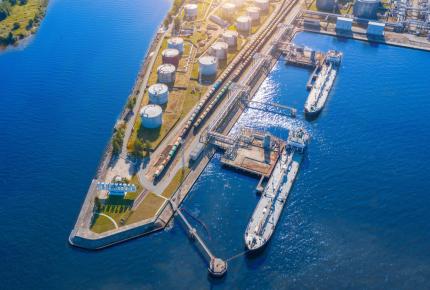An industry united for holistic LNG bunkering safety
Since the earliest waves of marine decarbonization, Liquified Natural Gas (LNG) has laid the groundwork for clean shipping. The global fleet currently includes 600 LNG carriers and 175 LNG-fueled vessels[1], and LNG-powered ships comprised nearly 30% of new orders in 2021[2]. This rise in LNG activity has been accompanied by wide-ranging infrastructure developments, with LNG bunkering facilities dotting coastlines throughout North America, Europe and Asia.[3]
However, while the risks of LNG as fuel are well-known, safety procedures concerning LNG transfer and bunkering are still unstandardized, varying greatly by region. This can lead to confusion for newcomers on the LNG market, and leave assets and crew members vulnerable to otherwise manageable risks. These risks can be offset through industry-wide collaboration – including shipowners, equipment manufacturers, and classification societies –to establish common guidelines for the safe use of LNG.
Three types of LNG transfer
Risk to LNG-fueled ships is at its highest during bunkering, when LNG is transferred onboard from another vehicle, vessel or container. The most common type of bunkering is Mobile-to-Ship, in which trucks provide LNG to ships at port. Vessels can also undergo Shore-to-Ship bunkering, taking fuel directly from onshore LNG terminals, or conduct Ship-to-Ship transfer from floating storage units or bunkering vessels.
To avoid LNG bunkering risks – notably gas leaks and potential explosions – ships must be able to undertake safe LNG transfers. This requires vessels and bunkering facilities of all kinds to have compatible shapes and functions, and be equipped with the right connections.
Which regulations address LNG bunkering?
While there is no global regulation for the safe management of LNG bunkering systems, several standards and frameworks exist to guide ship and facility owners:
- The IGC Code[4] and ISM Code[5] lay out requirements for the design, safety and operation of bunkering facilities, ensuring compatibility for critical elements of the bunkering design interface
- The IGF[6] Code and ISM Code set rules for the design, safety and operation of LNG-fueled vessels, including interfaces and onboard equipment
- ISO 20519 and ISO 18683 are international standards that account for the design and safety of bunkering equipment
- SGMF[7] industry guidelines provide recommendations for all aspects of bunkering operations, including design, safety and training
The International Maritime Organization provides standards for conducting risk analysis and assessing bunkering connections for compatibility. Local authorities may also have specific requirements for bunkering activities that vary by port.
Managing bunkering risks during SimOps
The LNG bunkering process is complex, requiring specific equipment and training to complete safely from end to end. All parties must collaborate to ensure safe LNG transfer, determining and respecting exclusion zones to safeguard all non-essential personnel.
In the case of simultaneous operations (SimOps) – any secondary activity that occurs onboard alongside bunkering – ship and facility operators must take extra care. An increasingly common scenario concerns LNG-fueled containerships stopping at port to drop off cargo and refuel at the same time. This creates a delicate interplay of containers being offloaded while LNG connections are established and fuel is transferred onboard. Exclusion zones around LNG bunkering equipment must be established, with containers carrying dangerous goods being kept well away from transfer operations.
Beyond improving SimOps, today’s focus on LNG bunkering will lay the groundwork for the safe transfer of other alternative fuels. Operational safety protocols for LNG will find echoes in methanol and ammonia transfer, as stakeholders repurpose their knowledge of risk management, bunkering equipment and connections.
Global Market Leader, Sustainable Shipping
Bureau Veritas Marine & Offshore
The maritime industry has the potential to be a deeply collaborative environment, where shipowners, offshore operators, equipment manufacturers and classification societies come together to innovate. By contributing to the SGMF report, Bureau Veritas can share its considerable knowledge of LNG safety, and encourage an industry-wide atmosphere of trust to help advance marine decarbonization.
An industry-wide framework for bunkering safety
To help marine stakeholders perform LNG bunkering activities, the SGMF has produced new safety and operational guidelines. The SGMF counts nearly 150 members from across the maritime industry, including ship owners and operators, energy companies, port authorities and classification societies.
For the first time, the 2022 guidelines include real-world examples from SGMF members. This is a turning point, allowing the whole industry to benefit from the learnings of their collective experience, best practices, concrete examples and lessons learned. While not a compliance solution, the SGMF framework moves from the theoretical to the practical, providing users a holistic approach to LNG bunkering.
What Bureau Veritas brings to LNG bunkering
Bureau Veritas has over 60 years of experience working with LNG, having classed the world’s first LNG carrier. Since then, we have built up our expertise in the safety, technical and regulatory management of LNG carriers and LNG-powered ships. We offer dedicated Rules for gas-fueled vessels (NR529) and LNG bunkering vessels (NR620), and specific guidelines for bunkering operations (NI618).
Bureau Veritas has been involved with the SGMF since its founding, sharing our trusted third-party expertise with the marine industry. We believe that increased openness around best practices for LNG will benefit all stakeholders, improving performance for experienced operators and easing the transition for newcomers. Our goal is to support the development of standardized practices around LNG bunkering that are based on real-life experiences and industry-wide knowledge-sharing.
[1] https://sea-lng.org/why-lng/global-fleet/
[2] https://sea-lng.org/2021/09/lng-fuelled-vessels-approaching-30-of-orders/
[3] https://sea-lng.org/bunker-navigator/
[4] The International Code of the Construction and Equipment of Ships Carrying Liquefied Gases in Bulk
[5] The International Safety Management Code
[6] The International Code of Safety for Ships using Gases or Other Low-flashpoint Fuels
[7] Society for Gas as a Marine Fuel












